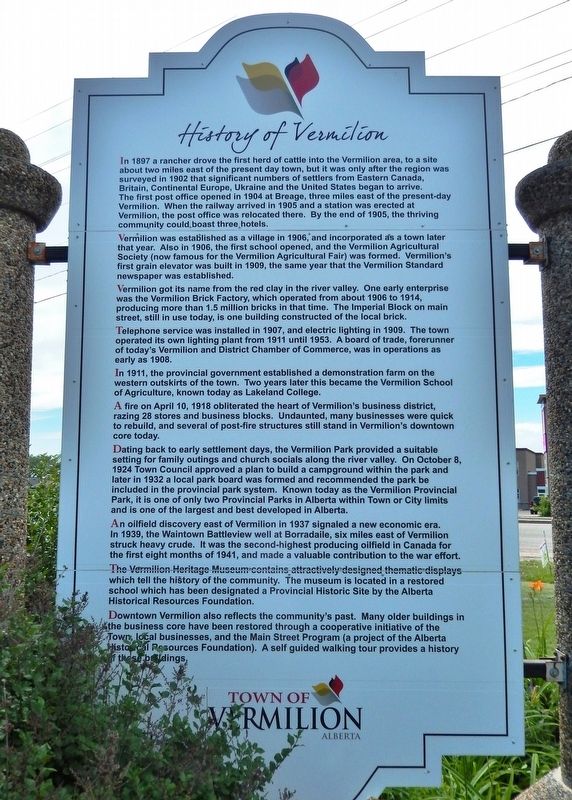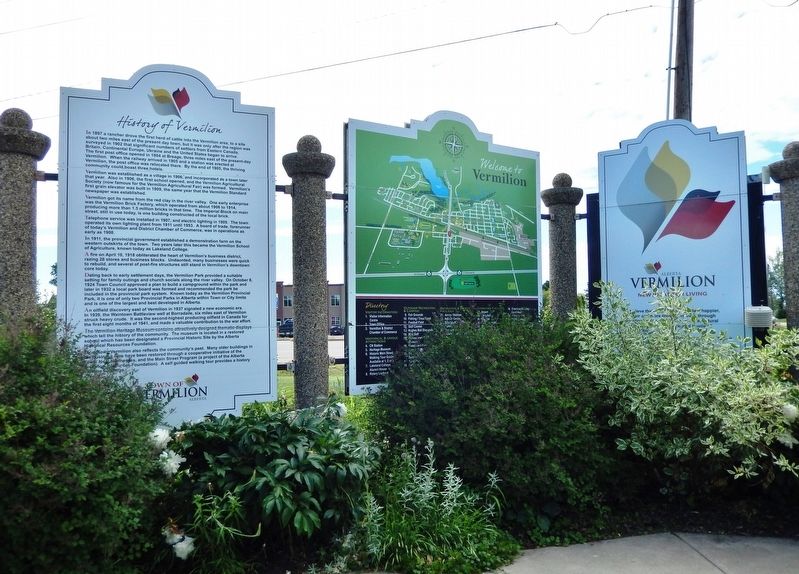Vermilion in Vermilion River County, Alberta — Canada’s Prairie Region (North America)
History of Vermilion
In 1897 a rancher drove the first herd of cattle into the Vermilion area, to a site about two miles east of the present day town, but it was only after the region was surveyed in 1902 that significant numbers of settlers from Eastern Canada, Britain, Continental Europe, Ukraine and the United States began to arrive. The first post office opened in 1904 at Breage, three miles east of the present-day Vermilion. When the railway arrived in 1905 and a station was erected at Vermilion, the post office was relocated there. By the end of 1905, the thriving community could boast three hotels.
Vermilion was established as a village in 1906, and incorporated as a town later that year. Also in 1906, the first school opened, and the Vermilion Agricultural Society (now famous for the Vermilion Agricultural Fair) was formed. Vermilion's first grain elevator was built in 1909, the same year that the Vermilion Standard newspaper was established.
Vermilion got its name from the red clay in the river valley. One early enterprise was the Vermilion Brick Factory, which operated from about 1906 to 1914, producing more than 1.5 million bricks in that time. The Imperial Block on Main Street, still in use today, is one building constructed of the local brick.
Telephone service was installed in 1907, and electric lighting in 1909. The town operated its own lighting plant from 1911 until 1953. A board of trade, forerunner of today's Vermilion and District Chamber of Commerce, was in operations as early as 1908.
In 1911, the provincial government established a demonstration farm on the western outskirts of the town. Two years later this became the Vermilion School of Agriculture, known today as Lakeland College.
A fire on April 10, 1918 obliterated the heart of Vermilion's business district, razing 28 stores and business blocks. Undaunted, many businesses were quick to rebuild, and several of post-fire structures still stand in Vermilion's downtown core today.
Dating back to early settlement days, the Vermilion Park provided a suitable setting for family outings and church socials along the river valley. On October 8, 1924 Town Council approved a plan to build a campground within the park and later in 1932 a local park board was formed and recommended the park be included in the provincial park system. Known today as the Vermilion Provincial Park, it is one of only two Provincial Parks in Alberta within Town or City limits and is one of the largest and best developed in Alberta.
An oilfield discovery east of Vermilion in 1937 signaled a new economic era. In 1939, the Waintown Battleview well at Borradaile, six miles east of Vermilion struck heavy crude. It was the second-highest producing
oilfield in Canada for the first eight months of 1941, and made a valuable contribution to the war effort.
The Vermilion Heritage Museum contains attractively designed thematic displays which tell the history of the community. The museum is located in a restored school which has been designated a Provincial Historic Site by the Alberta Historical Resources Foundation.
Downtown Vermilion also reflects the community's past. Many older buildings in the business core have been restored through a cooperative initiative of the Town, local businesses, and the Main Street Program (a project of the Alberta Historical Resources Foundation). A self-guided walking tour provides a history of these buildings.
Erected by Town of Vermilion.
Topics. This historical marker is listed in these topic lists: Agriculture • Industry & Commerce • Parks & Recreational Areas • Settlements & Settlers. A significant historical year for this entry is 1906.
Location. 53° 21′ N, 110° 51.493′ W. Marker is in Vermilion, Alberta, in Vermilion River County. Marker is on Buffalo Trail (Provincial Highway 41) just north of 46 Avenue, on the right when traveling north. Marker is on the backside of the information kiosk located outside the Vermilion Visitor Information Centre. Touch for map. Marker is at or near this postal address: 4606 Buffalo Trail, Vermilion AB T9X 0A1, Canada. Touch for directions.
Also see . . . Vermilion, Alberta.
It was not until 1902 that a significant number of settlers arrived in this area of Alberta, mostly of British ethnic background coming from the east. Just west of Vermilion is the line between British and those of Ukrainian ethnic background having travelled mostly from the west.(Submitted on December 10, 2022, by Cosmos Mariner of Cape Canaveral, Florida.)In 1905, the Canadian Northern Railway arrived and a station was built. Throughout the days of steam, the railway was important to Vermilion. Vermilion was used as a divisional point. It had a water tower to resupply engines, a large roundhouse, an extensive yard, a wye, a turntable, and a bunkhouse for engine crews. With the decline of steam power in the late 1950s and early 1960s, the railway became less important.
Credits. This page was last revised on December 10, 2022. It was originally submitted on December 9, 2022, by Cosmos Mariner of Cape Canaveral, Florida. This page has been viewed 201 times since then and 39 times this year. Photos: 1, 2. submitted on December 10, 2022, by Cosmos Mariner of Cape Canaveral, Florida.

